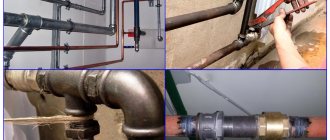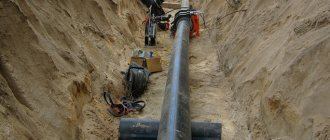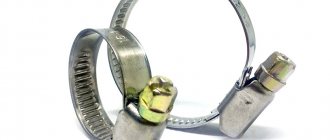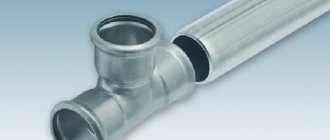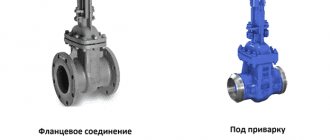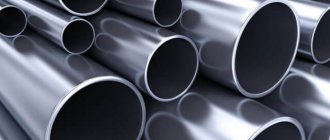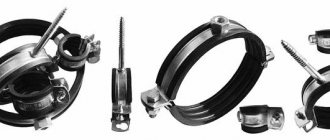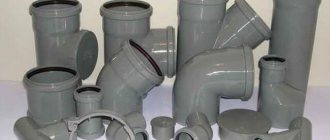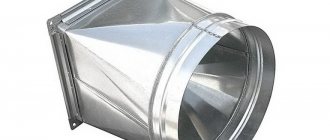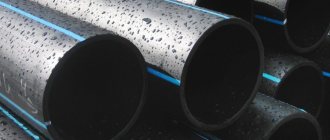Collection TER(FER)16 Internal pipelines.
Mistakes that should not be made:
1) First, it is necessary to distinguish fittings from fittings. Shaped parts are a tee, adapter, bend, pipe, cross, etc. Fittings are a gate valve, valve, ball valve, valve, etc.
2) Fittings can be flanged - this is when flanges are welded to the ends of the pipe and fittings are attached to these welded flanges, at the ends of which there are also the same flanges. And there are coupling fittings - this is when a thread is cut on the fittings and a thread is cut at the end of the pipe, and the fittings are attached to the pipe simply by screwing in without welding.
3) A pipeline differs from a pipe in that it consists of ready-made components necessary to perform a particular job, i.e. pipes with fittings.
So this is what it's all about:
When laying pipelines, fittings are not taken in addition to the prices for laying pipelines, since they are already included in the cost of the pipeline, which is included in these prices for laying pipelines .
When installing coupling fittings, no work is taken separately for installing coupling fittings , since its installation does not require welding and the labor costs for its installation are included in the work of laying pipelines. In addition to the price for laying pipelines, only the cost of coupling fittings, if any, is taken into account when laying pipelines.
But when installing flanged fittings, work is taken on its installation , since welding is required when installing flanges on the ends of the pipe.
And don’t forget to look at the price from the inside, i.e. which materials should be taken in addition to the price, and which are already included in the price. Many prices for installing flanged fittings include the cost of fittings with the letter “P” and the cost of flanges with the letter “P”. (see Tip 6)
When installing flanged fittings, NOT FORGET TO TAKE THE COST OF FLANGES and DO NOT FORGET TO TAKE THE COST OF TWO FLANGES per unit of fittings, since flanges are needed at one and the other end of the pipeline section in the place where the flanged fittings will be located.
The simplest coupling fittings are a hollow cylinder with a thread on the inner wall. A threaded coupling is used to connect two pipes or metal rods to each other. The part is widely used in modern construction technologies, as well as when laying gas and water communications. Connection using coupling fittings does not require special equipment or special skills. This is a simple, convenient and reliable way to connect segments of pipes or metal rods.
Purpose of coupling fittings
A threaded coupling is a connecting fitting that is actively used in the laying and distribution of pipelines, as well as in construction. The main purpose of coupling fittings is to connect elements end to end, without changing direction. Manufacturers produce couplings from various alloys and polymers.
Note! Threaded coupling fittings are used to connect not only metal but also polymer pipes.
Coupling fittings allow you to connect metal structures without the use of welding, glue or additional fasteners. The connection is removable. To ensure the tightness of threaded connections on pipelines, a special winding, linen or polymer, is used.
Construction technologies using threaded coupling fittings allow the construction of high-rise buildings at lower costs. The coupling allows you to connect metal rods quickly, without additional material costs for a welder and materials.
Advantages
- Ability to connect rods at any angle.
- Special connecting devices increase the intensity of assembly work.
- Identical connectors guarantee a high-quality joining process.
- Economical use of reinforcing pins.
- Connecting blocks are used without restrictions.
- A simplified visual method for monitoring the quality of joints.
- Regardless of the concrete mass, the reinforcement frame maintains its integrity.
- Eliminating the need to hire qualified welders saves financial resources.
- Strength is distributed evenly along the entire length of the pin.
- The features of the equipment used reduce construction time.
- Thread cutting is carried out with universal devices by rolling or stamping.
Installation of coupling fittings significantly simplifies and speeds up the process of constructing monolithic buildings. Practice proves that a rod tens of meters long, assembled with coupling fastenings, is not inferior in reliability and strength to a solid rod (not divided into segments).
Design features of the coupling
The coupling is a hollow metal cylinder, inside of which there is an inch (pipe) thread with a fine pitch. The tube body is equipped with special turnkey hooks or made in the shape of a hexagon. The term "muff" comes from the German "mouw", which means sleeve. The connection does not require additional fasteners - the ends of the pipes are inserted into the coupling, as if into a sleeve, and twisted.
The thread is applied in such a way that when the coupling is tightened, both ends to be connected are simultaneously pulled into it. It is important that the thread at the end of the pipe or rod is half a thread smaller than the thread inside the coupling. When tightened, this prevents the pipe from resting against the coupling body.
There are right-hand threads on both sides of the coupling, as well as on the ends of the parts being connected. The method of applying threads can be any: stamping, rolling or cutting. When screwing the coupling, it is forbidden to increase the arm of the wrench with additional attachments, since excessive force will strip the thread.
Note! The connection using threaded coupling fittings is performed manually. The required physical force is directly proportional to the diameter of the pipeline, therefore, for communications with a nominal diameter of more than 50 mm, threaded couplings are not used.
Large diameter connections are made using flange or crimp couplings.
Threaded couplings for building reinforcement have a wall thickness of 2 to 5 mm, part length from 7 to 20 cm. They connect rods from 12 to 50 mm in diameter.
Threaded pipeline couplings are sized according to the diameter of the pipes. Produced from cast iron, steel, stainless steel, brass, galvanized.
You can purchase pipeline fittings for connection to any system from the RU100 company!
In our catalog we always have pipeline equipment from leading manufacturers in the industry. We will select the appropriate equipment specifically for your system. We work directly with suppliers, we have our own warehouse, so prices remain low. We are a reliable supplier of pipeline fittings!
- Our engineers have been working in the industry since 2008. We know what we sell and will be happy to help you choose the right model.
- We will deliver your order throughout Russia! Or pickup from our warehouse in Moscow is possible.
- Placing an order is very simple.
- We work with both individuals and legal entities.
- We provide a complete set of documents.
- We accept payment in cash, non-cash, bank cards (for pickup)
Still have questions? The answer may already be in the FAQ section.
Enjoy the convenience of working with RU100!
Application of coupling connection
There are two directions where coupling fittings on threads are used:
- Laying pipelines with a diameter of up to 50 mm - coupling fittings are designed for connecting pipes.
- Construction of monolithic reinforced concrete structures - couplings are used to build up a metal rod in the frame.
The construction of monolithic structures made of concrete requires the creation of a strong, solid frame made of metal rods. Until recently, the frame was knitted by hand, using special wire and welding. The use of coupling reinforcement on a thread allows you to create a strong metal frame that prevents concrete from collapsing. Research shows that a coupling joint is not inferior in strength to a solid product.
Construction coupling fittings
Mechanical joining using coupling fittings simplifies quality control of frame extensions.
The work is carried out according to the following scheme:
- Couplings of the appropriate size are purchased in the required quantity (the inner diameter coincides with the outer diameter of the rod).
- Threads are cut at the ends of the rod (slightly shorter than in the coupling).
- Install the initial reinforcement.
- Screw on the coupling.
- Attach the next metal rod.
- The connection is tightened to the extreme position.
- Work on standard parts is carried out using a torque wrench, which eliminates the need to control every tightening.
Assembling the frame of a monolithic structure using coupling fittings does not require the involvement of qualified workers. When using standard rods and a torque wrench, visual quality control is sufficient. Extended coupling reinforcement distributes the load evenly across the entire pin, strengthening the joint. The same type of parts guarantees uniform strength of the entire frame.
Note! Transition couplings allow you to connect pins of different diameters.
Pipeline coupling fittings
Traditionally, cast iron couplings with a diameter of up to 50 mm are popular when installing pipelines. Steel and brass parts are slightly inferior to them. They are used in systems designed for operation under a pressure of 10 atm. Aluminum and duralumin couplings are used less frequently. Products made of porcelain, ceramics and glass have a special purpose - they connect pipelines for chemically aggressive liquids.
Stages of assembling longitudinal reinforcing pins with threaded couplings
- Couplings of appropriate sizes are purchased and equipment is prepared.
- Threads are cut at the ends of the rods.
- The fittings are installed in the working position.
- The coupling is screwed on at one end.
- The second end is screwed on.
- The knot is tightened to its extreme positions.
- The build quality is checked.
In order to prevent problems with the condition of the frame in the future, it is necessary to tighten the reinforcement units efficiently and with special keys.
Reinforcement connected by the coupling method forms a very strong connection. For such an assembly there is no need to hire expensive specialists. It is enough to simply connect the prepared ends of the pins and secure them with the appropriate metal cylinders.
What it is?
Pipeline connecting fittings come in several types, some of them are mounted by welding, others are fixed with a fitting, plastic products are soldered. But the threaded design has remained the most common for many decades. Such a coupling, angle, tee or shut-off valve is equipped with female threaded fittings that simply screw onto the end of the pipe.
The coupling connection of the reinforcement is reliable. Its tightness is achieved by winding flax tow, fluoroplastic sealing material or a special viscous lubricant onto the thread turns.
There are PVC couplings, the connection of which is carried out not only by threading, but also by pressing.
Features and purpose
Coupling fittings are designed to connect parts of pipes made of different materials in the event of replacing a section of the main line, installing an additional fitting, branching the system or turning it, in some cases for installing a blind end with the possibility of extending the pipeline in the future.
The peculiarity of this element is its versatility. The product can be used in systems made of metal, metal-plastic and plastic pipes. Regardless of the material, maximum tightness and durability of the joint is ensured.
Couplings are available in various configurations and sizes, which allows you to choose the most suitable option in each individual case. In this case, installation is carried out quickly and without the use of special tools (except for cases when it is necessary to cut threads on the pipe).
Coupling fittings are used in everyday life, in the gas and oil industries, when laying cold and hot water supply lines, and for installing heating mains.
Operating principle and design
Coupling fittings are a piece of pipe with connecting pipes on both sides, equipped with internal threads (in the case of metal products) or a rubber sealing gasket (in plastic parts).
Inch threads on couplings are formed by rolling, cutting or stamping. Moreover, due to the fine pitch, the height of the teeth does not affect the diameter of the pipeline in any way. To ensure quick screwing of the product from the outside, the ends form a hexagon for keys. Apart from this tool, you won't need anything else.
The design of the American coupling eliminates the need to rotate the entire part. The pipes in it are replaced with union nuts. For tightness, the product is equipped with a firmly fixed gasket in the form of a ring on the outer surface of the housing.
PVC couplings are used when laying sewers, water pipes, organizing irrigation, etc. They can be either threaded or equipped with a rubber seal for a tight connection with the outer surface of the pipe.
Flange connection
This is a connection using two metal plates adjacent to each other. The plates have holes through which bolts or studs pass and are tightened with nuts on the other side, thus pressing the flanges together. For greater reliability and tightness of the connection, protrusions, grooves, etc. are made on the plates, and gaskets are installed between the metal plates. Most often the plates have a rounded shape, but this is not necessary. Occasionally you can find square flanges, rectangular or with three corners, but their production is more expensive. Such forms of flanges are used only when strictly necessary, for example, if space limitations require it. Used on industrial pipelines with a diameter of DN 50 mm.
The word “flange” comes from the German flansch, which means the same thing as in Russian – a flat metal plate with holes.
Flange connection is one of the most popular connections in pipeline fittings. For the manufacture of flanges, cast iron is most often used - gray or malleable, as well as steel of various grades. Gray cast iron is the most inexpensive solution, but ductile iron can generally withstand a greater range of pressures and temperatures. An even more expensive and durable solution is cast steel flanges. But at the same time, steel is more susceptible to plastic deformation than cast iron, which is brittle but holds its shape well.
Video: installing a flanged LD ball valve on a pipe using mating flanges
Advantages of flange connection of pipeline fittings
- Strong, reliable connection.
- Withstands high pressure.
- High tightness. But it depends on the seals used.
- Can be mounted and dismantled many times.
Flaws
- Large overall dimensions of the flange connection. Large mass.
- High metal consumption and labor-intensive production, and therefore the price.
- The bolts holding the flanges together must be tightened periodically to ensure proper tightness. This is especially important in systems where the pipe is subject to vibration (solved by installing a vibration compensator in front of the flange connection) or temperature changes.
Advantages and disadvantages
The most important advantage of coupling fittings is ease of use without the need for complex tools. Everything you need is included in the product body. It is also important that the connections are made tightly and firmly. The joint is able to withstand mechanical loads and high temperatures.
Threaded fittings do not require twisting of the pipes, since the turns are arranged in such a way that screwing occurs simultaneously on both sides. This is important when the highway is modified.
Any type of coupling has high performance characteristics that allow them to be used for several decades.
The disadvantages include the fact that when screwing the nut, physical effort has to be applied, so such fittings do not have large diameters. When laying large pipelines, it is better to use the flange method. In addition, it is not recommended to use threads on thin-walled pipes, as this significantly reduces their strength.
Marking of shut-off valves
All shut-off valves must comply with GOST and have markings that indicate the manufacturer of the product, body material, DN, direction of flow of the working medium, and working dimensions.
Marking is applied to the body of the product using one of three methods: branding, stamping, engraving. For example, let’s decipher the marking 15kch916br.
- 15 — valve designation.
- Kch - malleable cast iron (material designation).
- 9 — drive (electric).
- 16 — type of construction (dimensions are indicated in the corresponding catalogue).
- Br - bronze seals.
Marking is carried out in accordance with GOST 4666-75.
Features of application
The most widespread use of coupling fittings is when modifying already installed pipeline systems. This includes creating branches, turns, installing functional elements in the form of a tap, valve or stopper.
There is a demand for equipping such a collapsible joint in places where the main line and the units and devices installed on it are constantly being replaced or reconstructed. This allows you to shut down at any time without dismantling the pipes.
The most recommended pipeline diameter is no more than 40 mm in areas with open access. When laying underground pipelines, it is better to use fittings that are welded or fixed with flanges.
Weld fittings
Welding of reinforcement is resorted to when the reliability and tightness of other types of connections is considered unsatisfactory. Welding is especially in demand when constructing pipeline systems in which the working environment is toxic, poisonous or radioactive liquids and gases. In this case, a welded connection, which, if properly executed, provides 100 percent tightness, may be the optimal, and often the only acceptable solution. It is only important that such a section of the system does not require frequent dismantling of equipment, the implementation of which will each time lead to complete destruction of the welded joints.
Thanks to welding, which combines fragments of a pipeline system into a single whole, it is possible to ensure harmony, or, in technical terms, structural compliance between all its elements - pipes and pipeline fittings. The main thing is that, due to differences in the mechanical properties of the welded joint and other components of the pipeline system, it does not become its weak link.
The connecting ends of the reinforcement are prepared for welding by leveling and grinding the surface of the welded fragments, removing the required chamfers.
Welded joints can be made in socket and butt. In the first case, the welding seam is located on the outside of the pipe. This option is usually used for steel fittings of relatively small diameter, installed in pipelines operating at high pressure and temperature of the working environment.
In the second case, the connection can be supplemented with a backing ring, which prevents distortion of the parts being connected. It is precisely these connections, characterized by reliability and absolute tightness, that are used when installing pipeline systems of hazardous production facilities, for example, power units of nuclear power plants.
Important advantages of welded connections, especially compared to flanged ones, are minimal weight, compactness and space saving.
Installation technology
The installation of couplings of various types during pipeline installation has several similar features:
- The edges of the pipe to which the fitting will be joined must be cut strictly perpendicular to the axis to ensure a tight fit of the surfaces to each other.
- For installation, you only need an adjustable wrench, additional sealing means and components suitable for the diameter.
The threaded method of connecting fittings implies the presence of a counter thread on the pipe. If there is none, you will have to use a tap and a die. Then the entire structure is joined and the coupling is screwed onto both pipes at the same time.
The American is installed in the following sequence: a crimp nut and an O-ring are put on the pipe, then its edge is inserted into the fitting and the structure is tightened with a wrench. At the end, both hexagons are turned simultaneously to ensure a strong connection.
Press couplings are installed differently: a pipe cut perpendicularly is inserted into a sleeve and pressed into place.
Types of connection equipment
The equipment for joining depends on the type of coupling used and the location of work. There are 2 types of machines available: for crimping and threaded fastening.
For crimping under construction conditions, mobile hydraulic presses are used, consisting of: a press, an oil station and high-pressure hoses. The press operates in semi-automatic mode. Control is carried out from a remote control built into the handle or manually.
Using a portable press, mechanical crimp fasteners form a reinforcement joint with high tensile strength. At the same time, the actual force to the temporary resistance of the compressed rolled product increases significantly and unlimited endurance is guaranteed.
Machine for thread cutting on fittings
The machines are designed to prepare joints for subsequent coupling fastening. They are applicable to rods with a diameter of 16 to 40 mm. Provide a maximum thread length at the outlet of up to 80 mm.
Depending on the cutting, there are 2 types of machines:
- For conical cutting. Mechanism of action: removing excess body from the reinforcement with cutters, followed by giving it a cone shape and cutting. Productivity - up to 1000 notches per shift.
- For cylindrical knurling. The reinforcement ribs are cut with cutters, and the notches are rolled with rollers. Can be used directly on a construction site with a productivity of 400 threads per shift.
Crimping machine
The machines provide a complete set of crimping technology. The system connects reinforcement in the range of 16-55 mm. The kit includes replacement dies for different rod diameters. The standard machine consists of the following components:
- Reinforcement press (stationary or portable).
- Pumping station.
- Winch for moving the press relative to the coupling.
- High pressure hose.
The machine creates a fastening that is identical in strength to a reinforcing bar. Managed by one operator. Can be used in any position in space.
What fitting couplings do you use?
Threaded
Crimping
